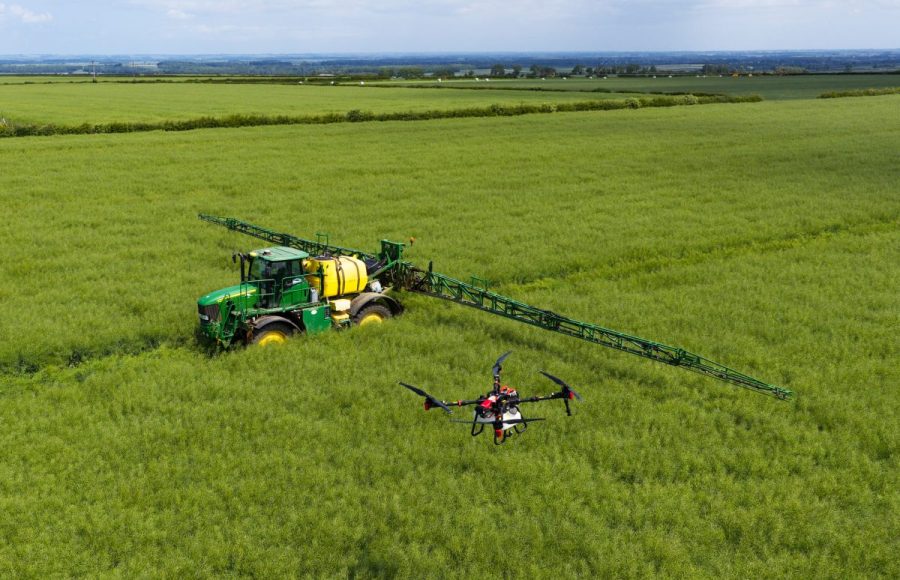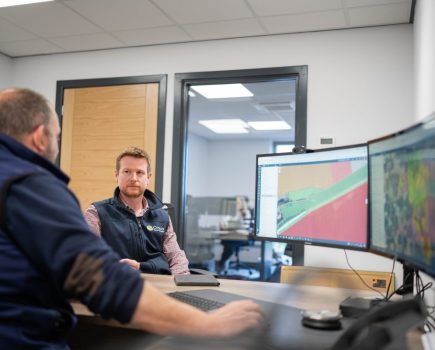Thanks to new legislation allowing drones to fly further than ever before, De Sangosse and AutoSpray Systems have brought spraying into the field with UK-first pod sealant trials. CPM finds out more.
“BVLOS is the step that makes drones a realistic, routine part of UK crop production.” ANDY SPRONSON
By Charlotte Cunningham
Agriculture has never been short of innovation, but few technologies have stirred as much debate – and disappointment – as drones. A decade ago they were hailed as the next frontier, promising precision spraying, rapid scouting, and targeted inputs. Yet regulations, reliability and the practicalities of covering large fields saw them quietly parked at the field gate.
Now, with the Civil Aviation Authority’s first permissions for BVLOS (beyond visual line of sight) operations in low-level rural airspace, drones may finally be poised to earn their place alongside tractors and sprayers in the UK arable system.
PIONEERS
At the forefront of the recent developments is AutoSpray Systems which became the first UK company to gain CAA permission for BVLOS operations in agriculture earlier this summer. But behind the scenes, SEAD Artists – a consortium of drone and data specialists including Autospray Systems, Skypointe, the University of Liverpool and DronePrep, – has been instrumental in helping establish the regulatory framework for BVLOS operations, ensuring that drones can fly safely beyond the 500m line-of-sight limit.
“The point is to make the machine do the work so people don’t have to,” explains Andy Sproson of AutoSpray Systems. “That means flying further, safely – and doing it to a professional spraying standard.”
So why exactly is BVLOS so important? Andy explains that conventional drone rules limit operators to 500m from the pilot, creating an invisible box that’s quickly impractical in real farmland. Fields roll, woods interrupt sightlines, and in upland or restoration projects the terrain makes line-of-sight impossible. “However, BVLOS changes the picture, extending the operational envelope to entire landscapes provided they’re pre-approved and risk-managed.”
To secure permission, SEAD Artists worked with regulators to address both ground risk and air risk. Ground risk was relatively straightforward: most agricultural sites are low population and low infrastructure. Air risk required more innovation, he explains.
“Drones are fitted with electronic conspicuity beacons so other air users can detect them, while ground units build a local air picture of nearby aircraft, alerting pilots to potential conflicts. Combined with data-declared environments – essentially dossiers proving that drones flying at 3m above a crop are unlikely to encounter other aircraft – the case was made.”
The CAA granted the first approvals in 2023 following trials funded by Defra’s Farming Innovation Programme. Each site still requires location-specific authorisation, but once approved, repeat operations are possible by issuing notice to airmen (NOTAMs) – a notification service to make airspace users aware of temperature changes to airspace. This makes BVLOS particularly suited to multi-year projects such as peatland restoration, habitat management, or in-field agronomy programmes like pod sealant sprays.
The possibilities of these new regulations is an area which AutoSpray Systems has been exploring in depth, most recently through a partnership with De Sangosse. This collaboration has specifically looked at the feasibility of applying De Sangosse’s Pod-Stik pod sealant to both beans and oilseed rape.
The first major field trial under this new framework took place in June 2025 with drone-applied Pod-Stik on OSR at Andrew Manfield’s farm on the Yorkshire Wolds.
At its core was the XAG P100 Pro – a quad-rotor, fully autonomous spray drone capable of carrying a 40-litre tank and covering up to 20ha/hr. The aircraft was programmed with precise flight paths and variable spray parameters: droplet spectra between 100-230 microns, a range of water volumes down as low as 25 l/ha, operating at a forward speed of 6m/s.
For Andrew, the trial addressed a very practical problem. “At 7ft tall, a crop like this can’t be treated without damage; even a self-propelled sprayer on narrow tyres will break stems and bruise pods. The drone flew 3m above the canopy and left no trace of physical damage.”
Stuart Sutherland, technical business manager at De Sangosse, explains the technical rationale: “Pod-Stik is a latex polymer designed to tack and seal the pod seam, preventing premature dehiscence from the weather or mechanical impact. Its effectiveness relies on uniform coverage of the pod surface.
“With the drone, we used fluorescent tracer dyes to evaluate deposition patterns and were able to demonstrate not only full coverage across the top canopy, but penetration into the mid-zone where pods are highly vulnerable yet hard to protect with a conventional boom sprayer.
“A boom sprayer typically requires 150-200 l/ha for a pod sealant application, yet here we achieved desirable coverage even at rates down to 25 l/ha of water.”
WINTER BEANS
A month later, in July 2025, the focus shifted to beans at Park Hill Farm in Cambridgeshire. Grower Richard Cobbald hosted a 4ha trial of winter beans where pod set extended right down to the base of the plant.
“This was the best bean crop we’ve grown in over a decade,” says Richard. “Pods were set 6” (15cm) above the soil, which makes them incredibly vulnerable to shatter at harvest. Losing that yield simply wasn’t an option.”
In beans, pod shatter is often underestimated, adds Rob Suckling, commercial technical manager at De Sangosse. “The pods become incredibly brittle in hot, dry conditions, and losses can be extreme. Combines hitting ripe pods at harvest can scatter beans that are impossible to recover.
“Unlike OSR, where pod sealants are increasingly routine, beans haven’t had the same attention. But in fact, pod protection in beans is vital to safeguard yield.”
Again, the XAG P100 Pro was used, this time applying Pod-Stik at 1 l/ha under four spray regimes:
- 100 l/ha water, 350µ droplets, 6m/s
- 100 l/ha water, 230µ droplets, 6m/s
- 50 l/ha water, 230µ droplets, 6m/s
- 100 l/ha water, 230µ droplets, 12m/s
Deposition analysis revealed a critical difference in coverage between drone and boom application.
“We saw droplet deposits on the undersides of pods, especially those lower down – a target that conventional boom sprayers struggle to reach due to their horizontal spray angle and lack of directed airflow,” explains Richard.
Boom sprayers may require 150 l/ha or more to push spray into the lower canopy, but even then, they can’t lift droplets underneath the pods, where the seam needs sealing.
“The drone achieved that at 100 l/ha – delivering droplets down to the lower pods and up underneath them,” notes Rob. “That’s critical, because those are the first to ripen and the first to shatter. The drone’s rotor-induced downwash created a vortex effect, swirling droplets under the pods for complete coverage.”
Richard was quick to spot the evidence himself. “You could see droplets glistening on the back of pods – something our 36m sprayer simply couldn’t deliver. And all without wheelings or compaction.”
A common assumption is that drones increase drift, notes Rob. “However, coverage wasn’t compromised by speed. In fact, at 100 l/ha the 12m/s treatment gave better deposition than 6m/s.”
Both trials underline the agronomic potential. Pod shatter in beans can strip up to 50% of yield, while OSR losses commonly run at 10-15%. With pod sealants increasingly routine in OSR but underused in beans, drones provide a new way to apply these treatments at optimum timing and with improved precision.
For growers like Richard and Andrew, the benefits should extend beyond shatter protection; reduced water volumes, zero crop damage, and no soil compaction can all add up. “It’s not about replacing sprayers,” says Rob. “It’s about adding a tool that can do things sprayers can’t.”
The technology is now pointing towards wider uses with biostimulants, nutritional foliar products, and slug pellets clear candidates. “Slug pellets are a perfect example,” says Andrew. “You have to apply them when soils are wet and machinery can’t travel. With drones, you can just map the treatment zone and send it out.”
Andy agrees BVLOS is the key enabler. “With BVLOS, we can now operate beyond field boundaries, scale up to farm or estate level, and do so with a data-driven safety case. It’s the step that makes drones a realistic, routine part of UK crop production.”
LIMITATIONS
However, drone spraying isn’t without its constraints – payload capacity and battery endurance are among the limiting factors. A full payload typically gives 10-12 minutes of flight, covering roughly 1ha at 50 l/ha. To scale operations, ground crews must rotate multiple batteries through fast chargers and streamline tank refills.
For light-rate applications such as biostimulants, a single drone with efficient logistics may suffice, but for heavier inputs or larger sites, multiple drones flying in coordinated fleets will be required. AutoSpray Systems is already developing protocols for dual-drone operations, with synchronised flight paths to double effective capacity.
The trials mark a significant step towards normalising drones in UK agronomy, believes Andy. For now, their role is niche – applying pod sealants to pulses, biostimulants to OSR, or inputs in inaccessible terrain. But the technology and trained operators is moving quickly, he adds.
Both farmers see potential for drones in slug pellet application, where patchy treatments could benefit from aerial precision. Biocides in glasshouses and amenity settings are another opportunity already in operation. Longer-term, pesticides may follow, although regulatory approval could be more complex.
For Andy, the journey is about building confidence. “10 years ago, drones were hyped as the next big thing; that didn’t happen because the practical pieces weren’t in place. Now we have BVLOS permission, proper drift data, and real trials with products farmers want. It’s a foundation we can build on.”
Ultimately, as climate pressure shortens spray windows and soil protection rises up the agenda, drones offer something conventional machinery can’t – access without compaction. Andy adds that they’re unlikely to replace self-propelled sprayers, but could become a vital complement, stepping in where wheels can’t go. He says the first UK pod sealant and OSR biostimulant trials show what’s possible – and with further work on molluscicides, biologicals and pesticides, the sky may indeed be the limit.
“Drones aren’t here to take work away from sprayers,” concludes Andy. “They’re here to give farmers another option. When the weather closes in, or the ground won’t take a machine, that option could make the difference between losing yield and saving it.”
This article was taken from the latest issue of CPM. Read the article in full here.
For more articles like this, subscribe here.
Sign up for Crop Production Magazine’s FREE e-newsletter here.




